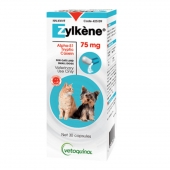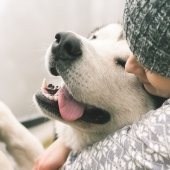Your cat or dog likely enjoys affection and being petted, but you may find that touching some areas causes your furry friend to react differently. Maybe you’re rubbing your dog’s belly and they start twitching their hind leg. Or that if you gently touch your cat’s paws, they’ll squirm and spread their toes. Are these signs that your pet may be ticklish?
Laughing, tickling and pets
There are two different types of tickling:
- Knismesis is defined as “sensitivity to a light touch not usually accompanied by laughter or vocalization”. It can produce a sensation of itching, and you may see your dog or cat’s skin shudder or your dog’s leg move.
- Gargalesis involves tickling with more pressure, and is associated with laughter in humans. While cats can meow, purr, hiss or scream and dogs can bark, growl and whine, they don’t emit sounds that match “laughing.”
For humans and animals, the response to tickling is involuntary, similar to when a physician taps your kneecap with a reflex hammer and causes your leg to jerk.
A dog’s tickle spots
Dogs may all react differently, just as some people are ticklish and others are not, or only when being touched in specific areas. Brushing or applying gentle pressure to spots like their ears, paws, neck, armpits and back may cause a tickle reaction. Dogs may respond by kicking or twitching their hind leg, scratching the air, panting, shivering or wagging their tail.
One possible explanation is that most of these areas are soft, vulnerable spots with a high density of nerve endings. Thus, the tickle response could trigger a defence mechanism to scratch a perceived itch or move away from the cause.
Observe your dog as you’re tickling them. If it looks like they’re smiling, with an open mouth and relaxed jaws, tongue lolling and gentle eyes, it’s probably a sign they’re enjoying themselves.
A cat’s tickle spots
Common areas where cats may be ticklish include their chin and cheeks, upper torso, belly, paws and back, especially the base of the tail. Felines who enjoy this sensation typically react the way they do when they’re happy, which could be by purring, kneading or brushing their head against your hand to urge you to continue.
When to stop tickling your pet
If someone won’t stop tickling you or makes you uncomfortable, you’re likely to get increasingly angry, warn them to stop and try to get away. Expect your dog or your cat to act similarly. For a dog, watch for warning signs such as tensing up, wagging their tail stiffly or tucking it between their legs, pinning their ears back, growling or snarling. A cat could pull back their ears, open their eyes wide, freeze, hiss, vocalize or bite with more insistency. You may keep your pet interested in a longer tickle session by varying your technique and not focusing on a single area. When your pet walks away, it’s a sure sign that they’ve had enough!





